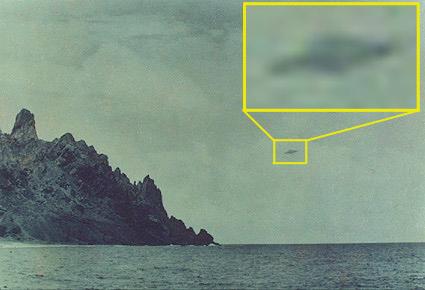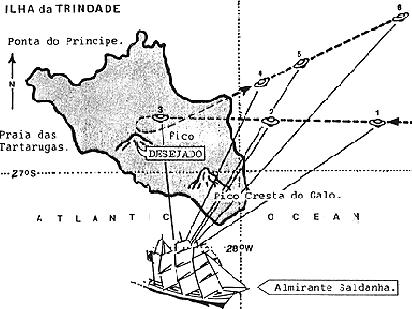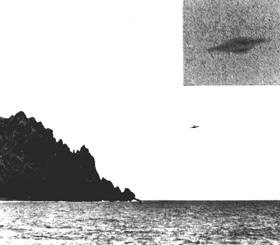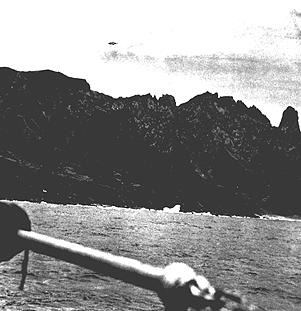 One of Almiro Barauna's photos. One of Almiro Barauna's photos.
|
|
Map of Trinidad Island showing the location of the ship and the trajectory of the UFO with the position where Barauna's photographs were taken: |

|
On February 21, 1958, the Brazilian newspapers Correio de Manha and O Jornalpublished a sequence of clear daytime photographs showing an oval object with a ring in the center, flying off the island of Trindade in the South Atlantic Ocean. The photos were taken by a professional civilian photographer, Almiro Barauna, on board the Brazilian Navy training ship NE Almirante Saldanha, which was conducting research for the International Geophysical Year (IGY). The Navy at first kept the matter secret, but the photos were eventually given to the press by the President of Brazil, Juscelino Kubitschek. (See the pictures.)0
Other high-ranking officials such as the Minister of the Navy, Admiral Alves Camera, were quoted in the press vouching for the photos. Following his weekly meeting with the President, the Minister told the United Press that "the Navy has a great secret which it cannot divulge because it cannot be explained." 1 On February 27th, Deputy Sergio Magalhaes of the House of Representatives formally requested the Navy Ministry to answer several questions about the photos and other prior UFO observations at the IGY post, maintained by the Navy in Trindade Island. 2
The Navy eventually released a detailed report on the matter entitled "Clarification of the observation of unidentified flying objects sighted on the Island of Trindade, in the period of 12/5/57 to 1/16/58," prepared by Captain of Corvette (CC), Carlos Alberto Ferreira Bacellar, Commander of the Oceanographic Station at Trindade. The report begins with a short summary of four UFO sightings by Navy crewmen and workers at the station from early December 1957 to mid-January 1958, including a phenomenon seen by Captain Bacellar with a theodolite (a surveying instrument for measuring vertical and horizontal angles). Four observations occurred in daytime and one at night; one was considered likely to be a seagull.
The report then introduces Almiro Barauna as "a professional civilian photographer who was on deck in the stern of the ship, ready to photograph the operation of hoisting the launch," when he was "alerted about the UFO" and was able to take four photographs showing the object. The crucial details of the development of the film are discussed:
"That, after having taken the above-mentioned photographs, the photographer, in the presence of CC Bacellar and other persons, took the roll of film from the camera; later, in the company of this official he went to the darkroom of the ship (improvised in the infirmary), dressed as he was in shirt and shorts, and where he remained only ten minutes, presenting at once the negative of the film to CC Bacellar, who affirms having seen the above-mentioned UFO represented on the negative, although with much less clarity because the film was somewhat dark." 3
An analysis of the facts in the report confirms there were may witnesses on deck of the Almirante Saldanha of "various qualifications - workmen, sailors, dentist, doctor, aviation officer and professional photographer," but no exact number is given. A report by Dr. Willy Smith, published by the Center for UFO Studies, indicates that "all in all, 48 ocular witnesses were on deck during the incident," although no source for this figure is provided. These included sailors, workers and the ship's dentist, as well as members of a civilian submarine diving group to which Baruana and Brazilian Air Force Captain (Ret.) J.T. Viejas belonged. 4
Captain Viejas' eyewitness description of the incident was published in the Brazilian press:
"The first view was that of a disc shining with phosphorescent glow, which -even at daylight - appeared to be brighter than the moon. The object was about the apparent size (angular diameter) of the full moon. As it followed its path across the sky, changing to a tilted position, its real shape was clearly outlined against the sky: that of a flattened sphere encircled, at the equator, by a large ring or platform. Its speed was around 700 miles an hour [1,100 km./hr.] at the moment it disappeared into the horizon."
Captain Viejas added that the sighting occurred at 12:20 p.m., causing "a tremendous confusion aboard. Mr. Barauna found it very difficult to operate his camera, being pushed and pulled by excited observers around him." 5 Neither CC Bacellar nor the Captain of the Almirante Saldanha, Jose Saldanha da Gama, observed the phenomenon, although they did see the commotion caused by the event.
Baruana gave detailed interviews to Brazilian reporters. His camera was a Rolleiflex 2.8 camera, model E, "set at speed 125, with the aperture at f/8." He shot the first two photos before the object disappeared behind the peak "Desejado." The UFO then reappeared, "bigger in size and flying in the opposite direction, but lower and closer than before, and moving at a higher speed. I shot the third photo." The fourth and fifth photos were lost when Barauna was pushed by other witnesses. The last photo in the roll of film was taken when the object was moving back toward the sea.
Barauna also disclosed that he had been interrogated for four hours at the Navy Ministry and that:
"Some days later I was called again. This time they [Navy] also asked for my Rolleiflex. They wanted to make tests in order to estimate, if possible, the speed of the flying saucer at the moment of the sighting. The tests were performed. They showed that I had taken my six pictures in 14 seconds, and that the saucer was flying at 900 to 1,000 km./hr. [550 to 600 mph]." 6
The negatives were analyzed by Navy and civilian experts from the Cruzeiro do Sul Aerophotogrammetric Service. The previously cited Navy document states that a technician from the Hydrographic Navy Department concluded there were no signs of tampering with the negatives which showed "the object photographed." A "more complete and thorough examination" was made by photo technicians from Cruzeiro do Sul (a private airline company), "including microscopic, for the verification of granulation, verification of signs, luminosity, and details of contour." The Cruzeiro experts concluded:
"There was on the above-mentioned negatives no sign of montage, all indicating it to be a negative of the object really photographed;
"Any hypotheses of later montage were removed; it would be impossible to prove either the existence or nonexistence of prior montage, which requires, however, extreme technical skill and circumstances favorable to its execution."
The Navy's final conclusion was very cautious, due to Barauna's reputation as a highly skilled photographer with some experience in UFO montages, which he had previously shown while refuting the 1952 Barra de Tijuca UFO photo case. The report's two final conclusions regarding the photos are:
"That the strongest and most valid testimony, that of the photographer, loses its definitely convincing character given the technical impossibility of proving if there was or not previous photographic montage.
"That, finally the existence of personal testimonies and of a photographer, of some value given the circumstances involved, permit the admission that there are indications of the existence of the UFO [underlined in the original]." 7

Enlargement of first UFO photograph taken by Barauna from a Brazilian Navy ship off Trindade Island.
Insert shows enlargement of UFO itself.

Enlargement of second UFO photograph taken by Barauna. Photographs (both) courtesy of ICUFON Archives.
In contrast to the careful and neutral style of the Brazilian Navy report, the U.S. Naval Attaché in Rio, the Office of Naval Intelligence (ONI) and Project Blue Book at the Air Technical Intelligence Center (ATIC), did not hesitate to label the Trindade Island UFO photos as a notorious hoax. The ONI Information Report from the Naval Attaché, while containing valuable data about the case and the position of the Brazilian Navy, is written in a very slanted negative style. It labels Barauna as a man with "a long history of photographic trick shots" and suggests that "the whole thing is a fake publicity stunt put on by a crooked photographer, and the Brazilian Navy fell for it." The coup de grace, however, is the final concluding remark by Captain Sunderland, USN:
"It is the reporting officer's private opinion that a flying saucer would be unlikely at the very barren island of Trindade, as everyone knows Martians are extremely comfort loving creatures." 8
Dr. J. Allen Hynek, Northwestern University astronomer serving as consultant to Project Blue Book, observed appropriately that "such bias and flippancy have no place in scientific investigations." 9
Likewise, Blue Book was quick to determine that "analysis of the Brazil picture by ATIC led to the conclusion that it was probably a hoax," although a "Record Card" admits that "this center [ATIC] has been unable to obtain copies of the photos."
10 This, despite the fact that Barauna's photos were widely available to the press and several UFO organizations both in Brazil and the United States!
Olavo T. Fontes, the late pioneer Brazilian UFO investigator and medical doctor, compiled an extensive report on the case for the Aerial Phenomena Research Organization (APRO) in the U.S., with transcripts of all the official statements and interviews published in the Brazilian press. Fontes disclosed additional sightings off Trindade Island, as well as other observations in the Atlantic Ocean from the Navy ships Tridente and Triunfo, and on the island of Fernando Noronha, located between Brazil and Africa, where "a U.S. guided missile and satellite tracking station" had just been set up. No official confirmation of the Noronha reports, however, was provided by Fontes. 11